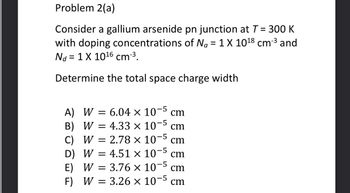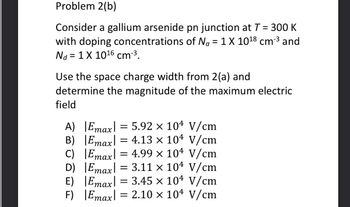
Introductory Circuit Analysis (13th Edition)
13th Edition
ISBN: 9780133923605
Author: Robert L. Boylestad
Publisher: PEARSON
expand_more
expand_more
format_list_bulleted
Concept explainers
Question

Transcribed Image Text:Problem 2(a)
Consider a gallium arsenide pn junction at T = 300 K
with doping concentrations of Na = 1 X 10¹8 cm-³ and
Nd = 1 X 10¹6 cm-³.
Determine the total space charge width
-5
A) W = 6.04 × 107 cm
= 4.33 × 10-5 cm
B) W =
-5
C) W = 2.78 x 107 cm
-5
4.51 x 10 cm
D) W
E) W
F) W
=
=
=
-5
3.76 × 10 cm
3.26 x 10-5 cm

Transcribed Image Text:Problem 2(b)
Consider a gallium arsenide pn junction at T = 300 K
with doping concentrations of Na = 1 X 10¹8 cm-³ and
Nd = 1 X 10¹6 cm-³.
Use the space charge width from 2(a) and
determine the magnitude of the maximum electric
field
A) |Emax = 5.92 x 104 V/cm
Emax 4.13 x 104 V/cm
=
Emax 4.99 × 104 V/cm
Emax = 3.11 x 104 V/cm
Emax = 3.45 x 104 V/cm
Emax = 2.10 x 104 V/cm
B)
C)
D)
E)
F)
=
Expert Solution
arrow_forward
Step 1: Define total space charge & electric field.
Electric field and total space charge are strongly connected. The entire space charge generates the electric field. The electric field is greater the more total space charge there is.
Pn junction functioning is significantly influenced by the electric field in the depletion zone. By preventing the diffusion of majority carriers over the junction, it also raises the possibility of a current flow barrier.
In a pn junction, the ionised acceptor and donor impurities in the depletion area produce the total space charge. In the depletion area, the electric field is directed from the p-side to the n-side.
Step by stepSolved in 4 steps with 13 images

Knowledge Booster
Learn more about
Need a deep-dive on the concept behind this application? Look no further. Learn more about this topic, electrical-engineering and related others by exploring similar questions and additional content below.Similar questions
- Consider a material where the probability of a hole occupying a state in the middle of the valence band at room temperature is 0.7, what type of material is this? O An insulator O A conductor There is no enough information to determine the nature of the material O A semiconductorarrow_forwardUsing constant-voltage diode model, where VDO = 0.5 V, plot vo versus vi. Make sure to show all steps, initial plots with dashed lines, final plot, amplitudes, slopes, intersection with axis, etc.arrow_forwardPlease give me explain clearlyarrow_forward
- In an n-type silicon sample, the donor concentration at 300 K is 5 x 1014/cm3 that corresponds to 1 impurity atom for 1018 silicon atoms. The electron and hole concentration in the sample will be: [Assume ni = 1.45 x 1010/cm³]arrow_forwardConsider an n-type silicon for which the dopant concentration is ND = 1016 cm-3. Find: a) The electron and hole concentration at T = 300K b) Repeat for T = 500Karrow_forward
arrow_back_ios
arrow_forward_ios
Recommended textbooks for you
 Introductory Circuit Analysis (13th Edition)Electrical EngineeringISBN:9780133923605Author:Robert L. BoylestadPublisher:PEARSON
Introductory Circuit Analysis (13th Edition)Electrical EngineeringISBN:9780133923605Author:Robert L. BoylestadPublisher:PEARSON Delmar's Standard Textbook Of ElectricityElectrical EngineeringISBN:9781337900348Author:Stephen L. HermanPublisher:Cengage Learning
Delmar's Standard Textbook Of ElectricityElectrical EngineeringISBN:9781337900348Author:Stephen L. HermanPublisher:Cengage Learning Programmable Logic ControllersElectrical EngineeringISBN:9780073373843Author:Frank D. PetruzellaPublisher:McGraw-Hill Education
Programmable Logic ControllersElectrical EngineeringISBN:9780073373843Author:Frank D. PetruzellaPublisher:McGraw-Hill Education Fundamentals of Electric CircuitsElectrical EngineeringISBN:9780078028229Author:Charles K Alexander, Matthew SadikuPublisher:McGraw-Hill Education
Fundamentals of Electric CircuitsElectrical EngineeringISBN:9780078028229Author:Charles K Alexander, Matthew SadikuPublisher:McGraw-Hill Education Electric Circuits. (11th Edition)Electrical EngineeringISBN:9780134746968Author:James W. Nilsson, Susan RiedelPublisher:PEARSON
Electric Circuits. (11th Edition)Electrical EngineeringISBN:9780134746968Author:James W. Nilsson, Susan RiedelPublisher:PEARSON Engineering ElectromagneticsElectrical EngineeringISBN:9780078028151Author:Hayt, William H. (william Hart), Jr, BUCK, John A.Publisher:Mcgraw-hill Education,
Engineering ElectromagneticsElectrical EngineeringISBN:9780078028151Author:Hayt, William H. (william Hart), Jr, BUCK, John A.Publisher:Mcgraw-hill Education,

Introductory Circuit Analysis (13th Edition)
Electrical Engineering
ISBN:9780133923605
Author:Robert L. Boylestad
Publisher:PEARSON

Delmar's Standard Textbook Of Electricity
Electrical Engineering
ISBN:9781337900348
Author:Stephen L. Herman
Publisher:Cengage Learning

Programmable Logic Controllers
Electrical Engineering
ISBN:9780073373843
Author:Frank D. Petruzella
Publisher:McGraw-Hill Education

Fundamentals of Electric Circuits
Electrical Engineering
ISBN:9780078028229
Author:Charles K Alexander, Matthew Sadiku
Publisher:McGraw-Hill Education

Electric Circuits. (11th Edition)
Electrical Engineering
ISBN:9780134746968
Author:James W. Nilsson, Susan Riedel
Publisher:PEARSON

Engineering Electromagnetics
Electrical Engineering
ISBN:9780078028151
Author:Hayt, William H. (william Hart), Jr, BUCK, John A.
Publisher:Mcgraw-hill Education,